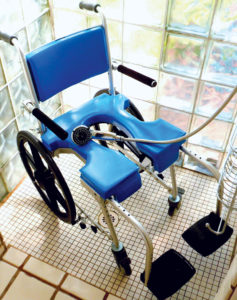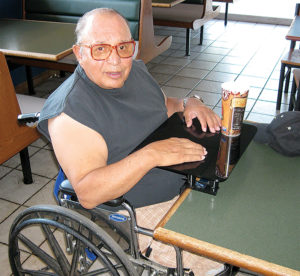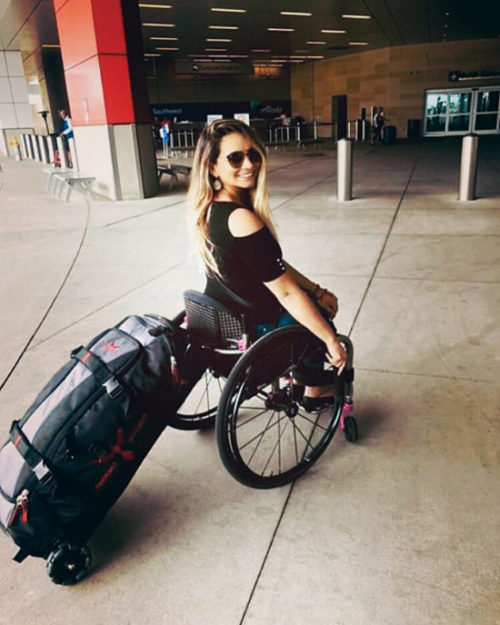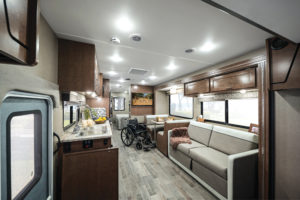By Rene Agredano
FOUR INVENTIONS FOR A BETTER LIFE ON THE GO
A spirit of adventure is not limited to people without mobility issues. But for those who rely on medical equipment, a trip by car, plane, or other methods pose frustrating challenges that can instantly crush anyone’s sense of wanderlust. Thankfully, travel is getting easier for mobility-impaired travelers. Today’s assistive device industry is flourishing with innovative products that minimize many types of travel frustrations.
THE GO! ANYWHERE PORTABLE COMMODE/SHOWER CHAIR LINE
Even the shortest journey can be fraught with obstacles for wheelchair users. Among them, the ability to discreetly haul a personal commode/shower chair on board an airplane or through a hotel lobby. The Go! Anywhere portable commode/shower chair line solves this problem with a unique design that enables the devices to fold down into their own ordinary-looking suitcases.

The personal travel device was created by Rick Goldstein, an Arizona entrepreneur and international wheelchair traveler. Goldstein wanted a practical, affordable way to deal with the hassles and embarrassment of taking his less-than-discreet commode/shower chair on airplanes. “I felt so restricted, and even though I had loved to travel, I would only do so when I absolutely had to,” he explains on his Go! Mobility Solutions website.
Working with a team of designers that included an engineer from the Mars Pathfinder Science Team, Goldstein developed a personal commode/shower chair that’s safe, lightweight, compact, comfortable, rust-proof, portable, and easy to assemble without any tools. And since U.S. airlines do not charge to transport medical equipment, users won’t incur any excess baggage charges when flying. Prices range from $1,425 for the basic combination model to $2,295 for a fully mobile version with 20-inch wheels.
HASSLE-FREE RESTAURANT DINING WITH THE PORTABLE TABLETOP EXTENSION
www.yourqualityoflifeproducts.com/home.html
As any wheelchair user knows, most dining tables make it difficult to reach a plate of food. But not with the Portable Tabletop Extension (PTE), a quality-of-life enhancer that bridges the chasm between wheelchair diners and place settings.

Necessity was the mother of this invention created by Curt Austin, a wheelchair user with muscular dystrophy who wanted a better way to dine out. Austin worked with his father to create a device that weighs less than a pound, sets up in 30 seconds, breaks down in 15, then stashes into its own carrying case. An optional Plate Rotator acts as a dish turntable for diners with upper-limb mobility limitations.
According to the company, the product is also 100 percent American made in Fresno, California, and is assembled by workers with disabilities.
PHOENIX INSTINCT LUGGAGE
Toting luggage around a busy airport is more comfortable with Phoenix Instinct’s Unstoppable line of travel bags. The innovative wheelchair-friendly suitcase is the brainchild of Andrew Slorance, an award-winning Scottish product designer and inventor of the CarbonBlack wheelchair.

A wheelchair user since the age of 14, Slorance used his travel experiences to create a must-have piece of luggage that wheelchair users can attach to their chair frame and independently maneuver whether traveling by air, train, or car. “The cool thing is that the wheels allow it to go in any direction so that it’s easy to move,” said British TV personality Sophie Morgan in her Unstoppable product review.
Buyers can choose from the Twin Set option, which includes a large check-in bag and a connecting hand luggage backpack, or the Compact bag for shorter trips. Phoenix Instinct offers free shipping to the United States, Europe, Canada, and Australia.
WINNEBAGO’S ACCESSIBILITY ENHANCED MOTORHOMES
www.winnebagoind.com/product-classes/accessibility-enhanced
Recreational vehicle travel seems like a no-brainer for mobility-impaired people who want to see the country. But in reality, typical RV layouts posed significant accessibility challenges for wheelchair, walker, and cane users. Until now.

Winnebago Industries’ three innovative, accessibility enhanced motorhomes make adventuring easier for people with disabilities and their service animals. Winnebago’s Intent 30R AE, Adventurer 30T AE, and Forza 34T AE RVs come standard with wheelchair-friendly features such as a platform wheelchair lift with an 800-pound lifting capacity, expanded hallway and bathroom areas, and an electric adjustable queen bed. Each model is fully customizable based on a buyer’s needs, from installing beds, toilets, and handrails in preferred locations to including specific furniture, cabinets, or an optional ceiling track system for wheelchair-free mobility. Base prices start at $202,295.

“Our accessibility enhanced RV has opened up a wider and richer world for our whole family and even makes day trips easier. We can leave the house with confidence and excitement, rather than anxiety and stress,” said Mike Freeman, a Winnebago Forza 34T owner, in a Winnebago press release.
The savvy adventure traveler Matt Walker once said, “At its core, adventure is the willingness to commit to an uncertain outcome with an open heart and an open mind.” Innovative designs like these are helping more and more wheelchair travelers leap straight past unpredictability and into the joy of a traveling journey.
WHEELCHAIR TRAVEL TIPS
Don’t let old ideas about wheelchair travel get in the way of your wanderlust. It’s a new day for accessible globe-trotting, with more ways than ever to see the world. From European rail trips to China and beyond, there’s never been a better time to explore your trekking dreams. Here are three quick tips from wheelchair travel expert and triple amputee John Morris of WheelchairTravel.org to help you get started:
- Look for travel agents who specialize in accessible travel. “New accessible tour companies are opening all over the world,” says Morris. Look for travel experts who hold the “SNG Certified Accessible Travel Advocate” credential, which ensures the agent has completed additional training to better meet the needs of special needs travelers. Spin The Globe / travel (http://spintheglobetravel.net) is one such travel planner.
- Don’t assume flying is easier than rail trips when traveling overseas. “Because many international trains are truly high-speed, taking the train is often faster than flying,” Morris says. Long-distance European trains have more accessible features, such as large, wheelchair-accessible bathrooms. The only U.S. trains that offer comparable accessibility features are found on the Amtrak Acela Express along the East Coast.
- Once you’re on your way, educate baggage handlers to lessen the risk of damage to mobility equipment. Whether traveling by air, ship, or train, Morris says it’s important to remember that baggage handlers aren’t wheelchair experts. You can reduce the risk of damage to your equipment by attaching visible operating instructions. Baggage handlers can then safely stow it in the cargo hold. Removable parts should always stay with you as carry-on luggage.
“Many wheelchair users believe that the world is inaccessible or off-limits, but accessibility is improving in destinations all around the world,” says Morris, an enthusiastic wheelchair travel blogger, speaker, and advocate. He has personally enjoyed these positive changes during his 750,000 miles of wheelchair travel adventures. “Businesses are beginning to compete in the accessible-travel marketplace, opening up new experiences and opportunities to people with disabilities. It’s a great time to be a wheelchair traveler.”
Editor’s note: Product inclusion in this article is presented for information purpose only. Endorsement is neither expressed nor implied and no compensation for inclusion was received from companies mentioned.



